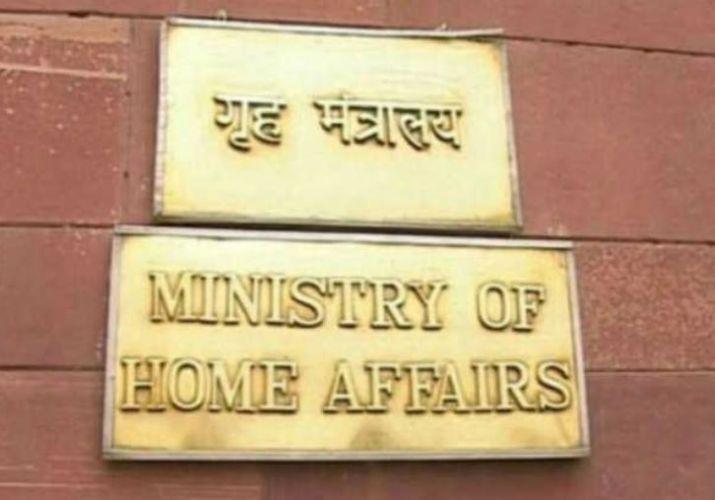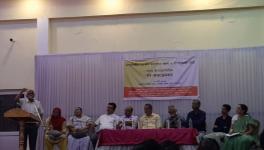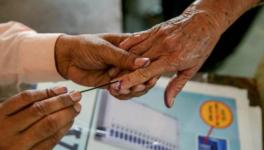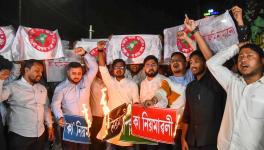Assam: Over 63,000 People Declared Foreigners Through Ex-Parte Proceedings, Admits MHA

Representational Image. Image Courtesy: PTI
New Delhi: Over 63,000 people in Assam have been declared foreigners by six foreigners’ tribunals through ex-parte proceedings till February 28, the Ministry of Home Affairs (MHA) told the Lok Sabha on July 2 in a written reply to Congress MP Dr Shashi Tharoor, who had sought details of detention centres across the state.
The ministry in its response said, “There are six detention centres designed to hold ‘Declared Foreigners’ in the State of Assam. (A total of) 1,133 (people are lodged in these detention centres) as on June 25, 2019. As on June 25, 769 (people have been languishing in these detention centres for more than a year). Three hundred thirty-five (people have been kept in these detention centres for more than three years) as on June 25.”
As for the number of people who have been kept in these detention centres and who have access to free legal aid provided by the government, the ministry replied without giving any number, “Free legal aid is being provided to detenues by the District legal Service Authority who are in need of it.”
Responding to a question seeking the total number of people who have been declared foreigners without they being present or represented, the MHA said, “(A total of) 63,959 persons have been declared foreigners through ex-parte proceedings by Foreigners’ Tribunals in Assam from 1985 to February 28, 2019.”
Also read: NRC: Five Missing Documents Bring Unease to the Barak Valley
As per data accessed by Commonwealth Human Rights Initiatives (CHRI) under the Right to Information (RTI) Act, 2005, there were 29 children held in three detention centres (Central Jail, Tezpur; Central Jail, Jorhat; District Jail, Kokrajhar), of which 16 are female and 13 were male. In addition, there were three births at two centres as well.
Eleven deaths have been reported from four centres, as of February 2019.
“We received detailed information about the 153 detenues being held at the Kokrajhar District Jail, such as their names, ages, relationship details, address in Bangladesh (where applicable), date of admission in the centre, date of transfer from other jails and case numbers. A little more than 13% – 1 of the 153 – are elderly persons (aged 60 years and above) and notably, none of them are shown as having an address in Bangladesh, unlike several younger detenues named in the list supplied by the detention centre,” Tahmina Laskar, Senior Programme Officer, Access to Information Programme, CHRI, told NewsClick.
FINDINGS ON NRC PROCESS
CHRI filed simultaneous RTIs regarding the draft National Register of Citizens (NRC) with the Office of the State Coordinator, NRC Assam and the nodal authority for the process, the Office of the Registrar General and Census Commissioner of India. The Office of the Registrar General and Census Commissioner of India transferred the RTI to the Office of the State Coordinator, NRC Assam.
The responses received from State Coordinator, NRC, Assam, directly and on the transferred RTI were the same. It only stated that “every hard copy of the Draft NRC was held in the offices the Deputy Commissioner, SDO (C), Circle Officer, BDO, NSK, Gaon Panchayat/VCDC and the Polling Station”. They pleaded ignorance on the remainder of the information sought on the total number of copies of draft NRCs, stating that this information was “not available”.
Responding to the queries seeking information on the process of updating the NRC, the Office of the State Coordinator, NRC, Assam, stated that for inclusion in the NRC, applicants were required to prove their eligibility by showing residence in Assam or any part of India up to March 24 (midnight), 1971, by submitting the “stipulated Legacy (List-A) and Linkage (List-B) documents”. However, the List-A and List-B documents (which are available with the official website of NRC Coordinator) were not included in the reply received.
The reply also said that persons deemed ‘D’ voters or doubtful voters, descendants of ‘D’ voters, persons against whom cases are pending in the Foreigners’ Tribunal, or the descendants of Foreigners’ Tribunals were kept “on hold” in the NRC. The reply stated that there is no information on standard operating procedure (SoP) for the inspection of the draft NRC by individuals.
To a question whether any quality checks were performed to verify the accuracy of entries in the draft NRC by Circle Registrars as mentioned in the Supreme Court’s Daily Order dated July 2, 2018 in the matter of Assam Public Works Vs Union of India and Ors. [Writ Petition(s) (Civil) No(s). 274/2009], a copy of a letter was provided containing instructions for these quality checks (QC), which also said that circle registrars had conducted 19,13,242 checks.
Also read: Detention Centres: A Balancing Act in Assam
“However, no information is available for incorrect entries into the NRC or who was accountable for them; neither was the number of Letters of Information (LoI) sent to those not included revealed to us,” she said.
The replies also denied offering any information on the district-wise break-up of applicants kept on hold and the number of LoIs sent to such applicants, stating that “this information could not be furnished as according to a Supreme Court order dated July 31, 2018 [WP (C) No. 274/2009 – APW vs Union of India & Others)”. However, a perusal of the order reveals that nowhere did the apex court embargo the disclosure of such information.
“These findings indicate a lack of clarity on the treatment of persons declared to be non-citizens by the NRC. Therefore, the fate of the persons held in detention centres in Assam too remains unclear; they might continue to remain there at least for the near foreseeable future without hope of release,” Laskar added.
THE NRC EXERCISE
The NRC was prepared last time after conduct of the Census of 1951, by recording particulars of all the persons enumerated during that Census. The Supreme Court-monitored latest NRC exercise in Assam –aimed at identifying illegal immigrants – will be updated to include the names of those persons (or their descendants) who appear in the 1951 NRC or in any of the electoral rolls up to the midnight of March 24, 1971 or in any one of the other admissible documents issued up to midnight of March, 24, 1971, which would prove their presence in Assam or in any part of India on or before the cut off date.
All the names appearing in the NRC 1951, or any of the Electoral Rolls up to the midnight of March 24, 1971 together are called Legacy Data. For getting their names included in the updated NRC, applicants shall have to submit application forms (family-wise). These application forms so received by the state government would be verified further and on the basis of these verifications, the updated NRC shall be prepared. However, to afford another opportunity to the applicants before publication of the final NRC, a draft NRC was published after verification of application forms and the applicants will be given chance to submit claims, objections, corrections etc. After verification of all such claims and objections, the final NRC would be published.
Also read: NRC: Only 8.75 Percent of Those Left Out have Filed Claims
When the draft NRC was published on July 30, 2018, there was a huge controversy over the exclusion of 40.7 lakh people from it. The draft NRC which was prepared last year had included the names of 2.9 crore people out of the total 3.29 crore applications. The final list of the NRC is expected to be published on July 31, 2019. The process of identification of illegal immigrants in the state has been widely debated and is a contentious issue in state politics.
Thousands are likely to be declared non-citizens when the NRC is finalised. But with no clear plan in sight on what will happen to those excluded from the NRC, the focus has shifted on creating more detention centres, which are constantly in news for all the wrong reasons. The issue, however, is much more complicated than it seems on the surface.
A BRIEF HISTORY
Assam saw two major episodes of large-scale migrant influx, during the Partition and in the run-up to the Bangladesh war in 1971. By the end of 1979, a popular resistance movement known as the Assam Movement took shape in Assam led by a students’ group, the All Assam Students’ Union (AASU), and an umbrella alliance of regional political parties, the All Assam Gana Sangram Parishad (AAGSP). The agitation demanding identification and deportation of illegal immigrants finally culminated in the Assam Accord, signed in 1985. The accord listed down a number of measures to be taken for the state to deal with the issue of immigration.
Section 6A of the Citizenship Act – introduced through an amendment in 1985 – was the legislative enactment of the Assam Accord. Section 6A divided “illegal” immigrants of Indian origin (i.e. those whose parents or grandparents were born in undivided India) who came into Assam from Bangladesh into three groups: those who came into the state before 1966; those who came into the state between 1966 and March 25, 1971 (the official date of the commencement of the Bangladesh War); and those who came into the state after 1971. The first group (pre-1966) was to be regularised. The second group (1966 – 1971) was to be taken off the electoral rolls and regularised after 10 years. The third group (1971-onwards) was to be detected and expelled in accordance with law.
Meanwhile, two years before the accord and Section 6A, Parliament had also passed the Illegal Migrants (Determination by Tribunals Act) of 1983 (IMDT Act). This Act authorised the government to set up tribunals for the purposes of determining whether migrants were illegal.
Under the Act, the government framed the Illegal Migrant Rules of 1984. The Illegal Migrants Act and Rules were challenged before the Supreme Court in the Sarbananda Sonowal vs Union of India case. Relying upon a 1998 report by the Governor of Assam, the Supreme Court held that there was a “flood” of Bangladeshi migrants into Assam, which the statutory regime had failed to check. This, the Court held, amounted to “external aggression” against the State of Assam, and under Article 355 of the Constitution, it was the duty of the Union to protect every state against external aggression. Holding the statutory regime of the Illegal Migrants Act and Illegal Migrants Rules to be directly responsible for this failure, the Court held the Act and Rules to be unconstitutional.
Therefore, the tribunals under the IMDT ceased to function, and the statutory regime reverted to Section 6A of the Citizenship Act, the Foreigners Act and the Foreigners Tribunal Order. Consequently, the statutory regime governing migration to Assam now became Section 6A of the Citizenship Act, read with the Illegal Migrants Act of 1983, and the Illegal Migrant Rules of 1984.
Get the latest reports & analysis with people's perspective on Protests, movements & deep analytical videos, discussions of the current affairs in your Telegram app. Subscribe to NewsClick's Telegram channel & get Real-Time updates on stories, as they get published on our website.
























